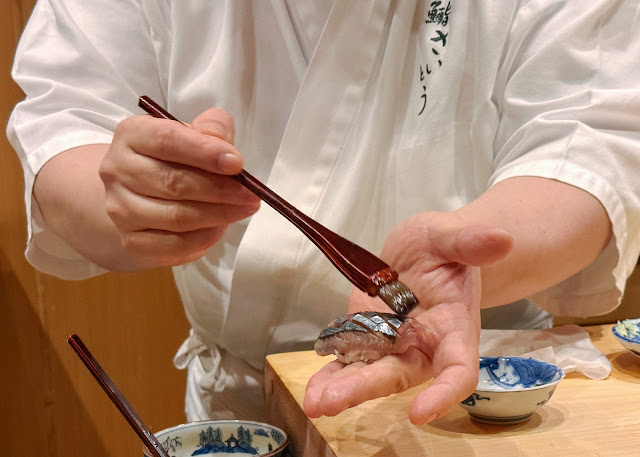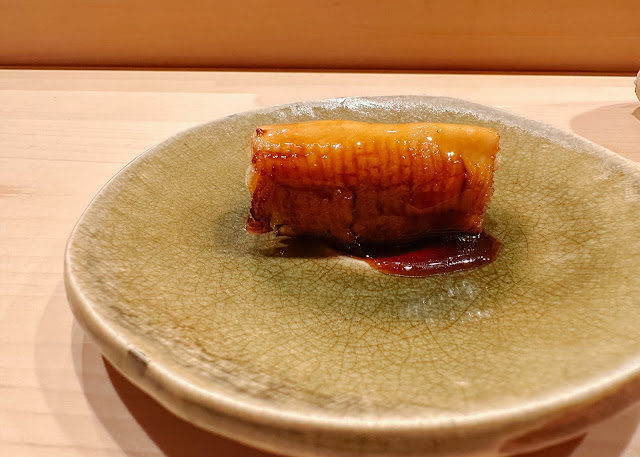Third sushi dinners in a month. In Hong Kong. That must be a first for us. So after Sushi Fujimoto and Sushi Nakamoto, we hit Sushi Saito with a few friends in early November. Friend is a regular of the restaurant, now helmed by Chef Masashi Kubota, and he asked us to come along for an early dinner booking he got.
With my dining experience at this sushi-ya being this one time a few years ago during lunchtime and I wasn't 100% convinced then (if I am being honest), I always wanted to try again now that they were well run and firmly established themselves as one of the top in town, or even anywhere outside Japan. We did exactly what we have been told, arriving promptly 5 minutes before our booking time and was seated in the smaller of the two rooms, which can seat 6 around the L-shaped counter. Chef Kubota soon made his appearance behind the counter and stayed until the last piece of food was served.

First to arrive was Ikura served in a small glass bowl. The salmon roes - which came in good size - were only mildly marinated thus the original refreshing flavor came out with the hint of nice aroma from the citrus zest brushed in. Katsuo (skipjack tuna) was prepared two ways and served in an antique earthenware dish - first the whole piece was gently warm-smoked and carved into thick slices and separately, katsuobushi (dried skipjack tuna flakes) was carefully shaved and served on top, in addition to the dab of grated ginger. Again, chef chose to showcase the original flavor with minimal invention, and katsuo, at its prime season during autumn, was fatty and got intense flavor at this time of year.


One ceramics dish was taken away and replaced by another rustic dish, this time with three different items served at once. First was the kuroawabi (Japanese black abalone) served as a couple of thick slices carved from a giant piece. Then it was the simmered tako (octopus) cut from the tentacles and shako (manthis shrimp) cut in halves. The abalone was slow steamed in sake until it reaches the tender consistency and served warm with the liver sauce on the side. The octopus was slow-cooked with basting of sweet tara sauce, let cool and the pieces cut from the thicker end of the tentacle area. Shako was cooked soft but not mushy and finished with a brush of soy sauce. Of course, the liver sauce was mixed in with rice so we could finish all the sauce up. All of them top notch - I particularly enjoyed the abalone with the best texture, bouncy and in perfect thickness. The color of the sauce was lighter than usual but then was the most intense I have tasted.

We got a couple more tsumami courses prepared with Hokkaido ingredients. First was Kegani (hairy crabs) served with the whole claw on top and picked meat at the bottom with a spoonful of mild vinaigrette, followed by a piece of Kinki (scorpion fish) grilled skin-on with a dab of grated daikon on the side. They are in my opinion some of the best I have tried.


Just as we were finishing up the starter courses, Chef Kubota-san prepared most of the neta before the sushi service began, carefully taking each piece out, carved to the serving size, either marinate in a bowl or placed in a wooden board, while the warm shari was brought out in small batches. We moved through the lighter pieces (hirame and shimaji) then sanma (pacific saury). One thing I noticed was the way Kubota-san varied the way the neta was seasoned, and even piece by piece, he carved or shaped the sushi piece slightly differently so they all came out perfect no matter the cut. It’s such a pleasure observing the cutting skills – he made it looked so effortlessly.

We moved on to the trio of tuna – all of them outstanding. The akami was slightly marinated before served and got good firm texture and rich flavor, while the chu-toro came in slightly thicker slice and have stepped up in fattiness, and of course, lastly it was the otoro with the softest texture, thanks of the cut chef made on top of the piece to tenderize. The kuruma-ebi (tiger prawn) was a redemption of the not-so-impressive piece I had just a few weeks back – perfectly cooked with perfect texture and shape. Two boxes of b bafun uni (sea urchins) were carefully brought out along with a big porcelain bowl, then Kubota-san carefully spooned warm rice into the bowl along with a generous amount of uni from one box and beginning mixing (like what one would done with risotto except no heat was involved). To serve, a small spoonful of uni-rice mixture was put in a small bowl, and topped with more uni (from the box of better quality), so we got a double whammy and full mouthful of uni.



The anago (sea eel) was steamed wrapped with hoba leaves (magnolia) as per the tradition, and served nigiri style with a brush of tara sauce. It was soft, delicate and full of flavor. The making of Futomaki was a ritual here at Sushi Saito, just as how Maestro Chef Saito-san does at the shop in Tokyo, with scores of ingredients nicely arranged and wrapped into a giant roll. Surprisingly one could really taste the individual components in each bite. The tamago-yaki was served in two different style – one more like cake done with shrimp broth, and one more wobbly like an egg pudding made using scallops mixed in. We finished with the seasonal persimmon, plenty of laughter and a full, satisfied stomach.
More photos:
https://www.flickr.com/photos/g4gary/albums/72177720303625173 When? November 6 2022
Where? Sushi Saito, 45th Floor, Four Seasons Hotel Hong Kong, 8 Finance St, Central
Menu Highlights? Everything!
Drinks?
Isojiman Junmai Daiginjo Omachi 40 - Isojiman Shuzo, Shizuoka Prefecture
磯自慢 純米大吟醸 雄町40 - 静岡県磯自慢酒造













No comments :
Post a Comment